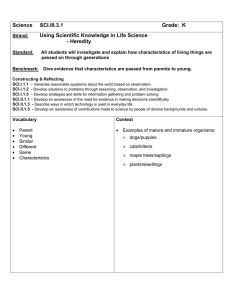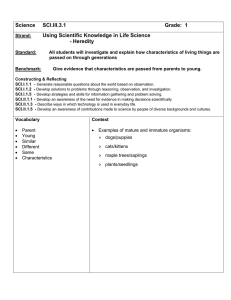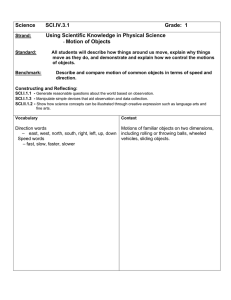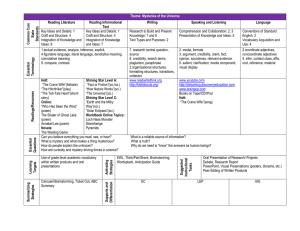Science SCI.III.3.1 Grade: 2
advertisement
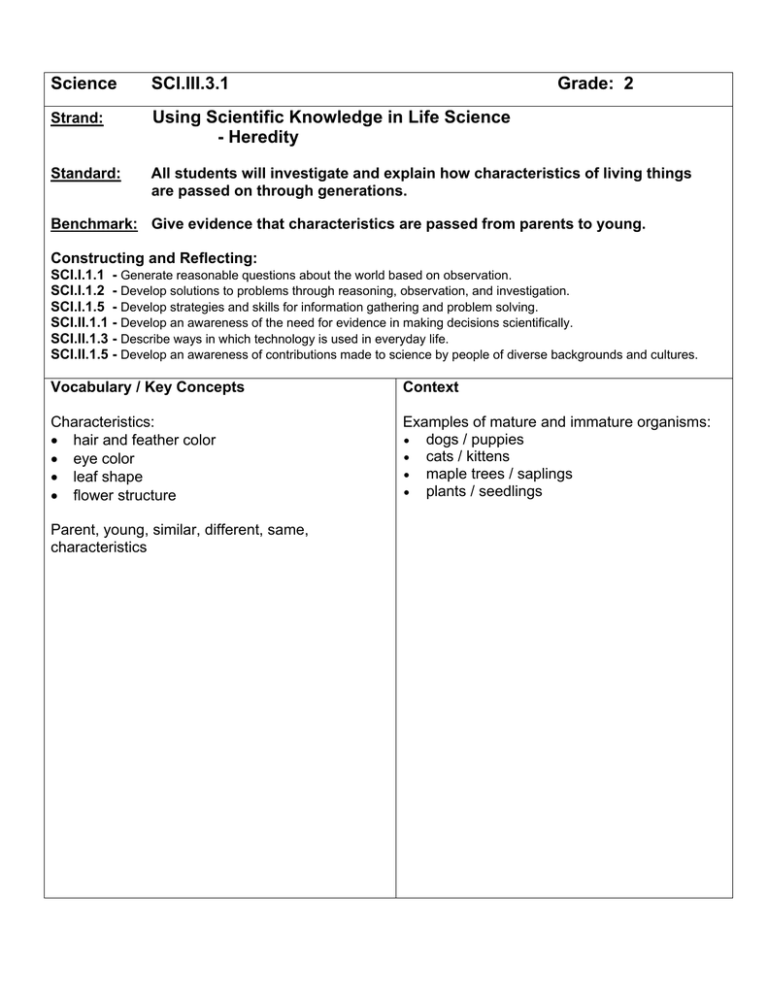
Science SCI.III.3.1 Grade: 2 Strand: Using Scientific Knowledge in Life Science - Heredity Standard: All students will investigate and explain how characteristics of living things are passed on through generations. Benchmark: Give evidence that characteristics are passed from parents to young. Constructing and Reflecting: SCI.I.1.1 - Generate reasonable questions about the world based on observation. SCI.I.1.2 - Develop solutions to problems through reasoning, observation, and investigation. SCI.I.1.5 - Develop strategies and skills for information gathering and problem solving. SCI.II.1.1 - Develop an awareness of the need for evidence in making decisions scientifically. SCI.II.1.3 - Describe ways in which technology is used in everyday life. SCI.II.1.5 - Develop an awareness of contributions made to science by people of diverse backgrounds and cultures. Vocabulary / Key Concepts Context Characteristics: • hair and feather color • eye color • leaf shape • flower structure Examples of mature and immature organisms: • dogs / puppies • cats / kittens • maple trees / saplings • plants / seedlings Parent, young, similar, different, same, characteristics Knowledge and Skills Benchmark Clarification: All living things pass on characteristics to their offspring. Common physical characteristics can be used to match the offspring of an organism with its parent. Students will: • Identify that a puppy looks like a dog • Identify that a kitten looks like a cat • Identify that saplings look like trees • Identify that seedlings look like plants Other Resources (continued from column at right) Teachers’ Domain – Multimedia Resources – video clips, narratives and photos of animals and their adaptations. Lots to choose from – AWESOME site! Resources Coloma Resources: Plant and Tree Posters Classroom Unit on The Life Cycle of a Tree Books: The Sunflower big book and teachers guide Maple Tree Book The Leaves Book How Birds Find Their Way Watch Me Grow Puppy “Inherited Humans” (activity on features we inherit) Goes to Seed Video Gets Planted Video http://www.teachersdomain.org/K2/sci/life/colt/subtopic_plants.html Other Resources: Michigan Teacher Network Resources http://mtn.merit.edu/mcf/SCI.III.3.E.1.html Whose Baby Are You? Card game http://www.frankschaffer.com/ National Geographic – Creature Feature http://www.nationalgeographic.com/kids/creatur e_feature/0103/elephants2.html Whose Baby Are You? 20 look and match photo puzzles http://www.livingandlearning.com/ Photos of mothers and babies (animals) http://shamus.250x.com/a5.html Guarino, Deborah, Is Your Mama a Llama? Scholastic,1997. National Geographic - Dinorama http://www.nationalgeographic.com/dinorama/ Explore and enjoy photos, information, and even sounds of hundreds of animals in the fascinating Animal Bytes database from Sea World. BCISD Classroom Resources – Life Science http://www.seaworld.org/animalbytes/animal%5Fb ytes.html Nature magazines, animal books, computer flipart. Biography or information about Charles Darwin. http://www.remc11.k12.mi.us/bcisd/classres/lsci ence.htm Instruction Assessment What Characteristics of living things are passed on Students brainstorm a set of parent / offspring through generations? organisms to create a Venn diagram. The diagram will illustrate the similarities and differences of the organism pictured on the Focus Question: What physical characteristics are shared between a young living thing and its cards or brainstormed. parent? Students will each select a plant or animal (encourage no repeats!). Each child then will obtain two pictures of that plant or animal, one as an immature organism and one as a mature organism. Pictures can be provided by the teacher or found on the computer. Students then will mount the pictures on two 3 x 5 cards. The teacher then will divide the class into small groups. Each member will put his or her two picture cards face down on a desk, mixed with the other members’ cards. In turn, students will flip one card over and attempt to find its mate. If no match is found after a child has turned up two cards, both cards are turned back over and play progresses to the next student. A student making a match must explain the shared characteristics to keep the matched cards. Play ends when all matches have been made. Coloma Instruction: Hang the Plant and Tree Posters Start this unit off by using the Sunflower big book with teachers guide. Show the “Goes to Seed” video Read The Maple Tree Book and The Leaves Book. Show the “Gets Planted” video Do the classroom unit on The Life Cycle of a Tree. (book will be in the Kit) Conclude by doing “Inherited Human” (Give students rubric before activity.) Scoring Rubric Criteria: Identification of common characteristics Apprentice - Identifies up to one of the shared characteristics. Basic - Identifies two of the shared characteristics. Meets -Identifies three of the shared characteristics. Exceeds - Identifies four or more of the shared characteristics-or-Identifies indistinct characteristics that may make a positive link questionable. Criteria: Completeness of Venn diagram Apprentice - Constructs a Venn diagram with data missing from one or more sections. Basic - Constructs a Venn diagram with data in all three sections; some data may be inaccurate. Meets -Constructs a Venn diagram with complete and accurate data. Constructs a Venn diagram and another graphic organizer with complete and accurate data. Teacher Notes: http://www.misd.net/mibig/ Investigate and explain how characteristics of living things are passed on through generations. Like produces like. To enable a child to understand why grandparents claim that they look just like their parents at their age requires many learning experiences. Elementary students should be able to provide evidence that visible traits are passed on from parents to children by comparisons of color, structure, and direct measurements. They should be able to match offspring to corresponding parents. By middle school, students should know how characteristics of living things are passed from generation to generation. Common traits controlled by a single gene pair should be taught in the middle school years as well as the reproductive cells which facilitate this happening. They should be aware that when the sperm fertilizes the egg, the sperm passes the genetic material (genes) of the father to the egg. The genes of the father's sperm and mother's egg then contribute to the formation of an entirely new individual having characteristics from both parents. Students at the high school level should understand that genes occur and act in pairs. If a dominant gene is present, it is fully expressed. A recessive gene will not be expressed in the presence of a dominant gene. A cross or combination of other gene pairs can show what future generations may inherit, or predict those chances of traits being exhibited such as sickle cell anemia and other genetic disorders.
